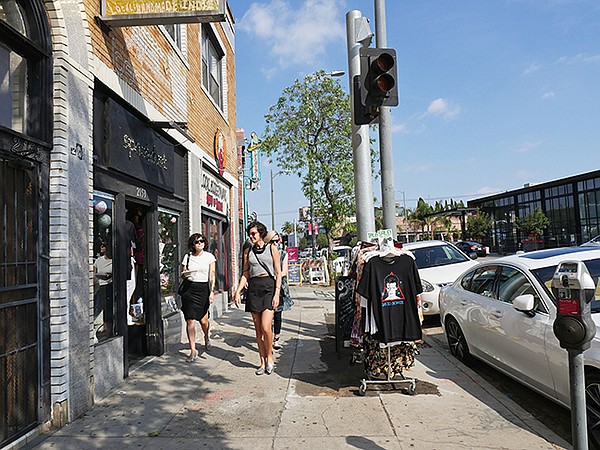ECHO PARK: New stores and investment are coming to Sunset Boulevard and Mohawk Avenue in Los Angeles’ Echo Park section. | Photo by Andrew Asch
BOUTIQUE STREETS SEEK CHANGE
Los Angeles Boutique Streets Undergo Change to Survive
The shopping mall—once considered mini–town centers that attracted after-school teens and early-morning exercising seniors—has struggled to stay competitive after consumers did an about-face and altered their shopping habits.
Cutbacks in store fleets and competition from e-commerce have battered the once unstoppable boxy shopping mall, leaving many B- and C-level malls with vacancy levels once considered unthinkable. Since then, mall owners have looked for ways to reinvent the mall.
While mall owners work out their new formulas, landlords and real estate brokers might be faced with a similar crisis on city streets. Generally, the real estate market for boutique-lined retail streets, called “high streets” in the United Kingdom, is healthier than it was during the economic downturn of 2008. But leading real-estate brokers say the market is still tough in Los Angeles.
“As spaces come available, tenants doing deals are becoming fewer and farther between,” said Jay Luchs, vice chairman of Newmark Knight Frank. “They are not expanding like in the last two decades.”
It may take a decade for the retail market to rebound, Luchs said. In the meantime, urban planners are revamping the retail-street model and looking for ways to attract more pedestrian traffic to high streets. While the model may be down, it certainly is not out.
In 2017, retail real estate is seeing mixed results. Market researchers CoStar Group Inc. found that retail real-estate business increased 2.7 percent during the first quarter of 2017 compared to the same period last year. Demand for popular locations remains strong.
With that in mind, developers continue to invest in retail streets and look for new possibilities to bring people to high streets. Similar to some malls, retail streets can support a wider array of tenants.
For example, health tenants and educational tenants could be moving into the spaces once reserved for retailers, said Larry Kosmont, president and chief executive officer of Kosmont Companies, which consults and brokers public and private real-estate transactions.
“You’re going to see a greater interaction between the private and the public,” Kosmont said. “Increasingly, there will be cultural and educational facilities as well as public amenities surrounded by private vendors.”
One development that is trying to incorporate a wider array of tenants is a project in Poway, Calif., near San Diego, that wants to build a town center in the small city. There will be parks, sidewalk cafés and other features that combine public and private uses. Currently it is going through the approval process with the city.
That town-center style of retailing is similar to projects designed by Caruso, the high-end shopping center developer owned by Rick Caruso, which are focused on a Main Street–centric design lined with boutiques, such as The Grove in Los Angeles.
Caruso architects have been inspired by high-street neighborhoods such as Newbury Street in Boston and the French Quarter in New Orleans. Caruso is developing another Main Street–centric project.
Next year, Caruso will unveil Palisades Village, located on Swarthmore Avenue, which is the main drag of the affluent Los Angeles seaside enclave of Pacific Palisades.
Even though the area is affluent—with Hollywood A-listers such as Reese Witherspoon and Steven Spielberg living there—local retailers heard complaints that the area’s shops were stuck in a rut. Retail sales have been declining for some time.
Caruso developers plan to bring the retail district back, in part, with the long-shuttered Bay Theatre cinema anchoring the project. Closed since 1978, it will be restored, owned and managed by Cinépolis Luxury Cinemas.
According to a Caruso statement, Jennifer Meyer, an independent jeweler who sells her designs at Barneys, will open her first store at Palisades Village. More than 50 boutiques, independent grocers and restaurants are also scheduled to move into the park-lined area.
Other old neighborhoods around Los Angeles are finding new retail life. The cross streets of West Sunset Boulevard and North Mohawk Street in Los Angeles’ Echo Park neighborhood have been an intersection of vintage stores and unique retail for more than 15 years.
Recently, two independent stores moved into the area, anchored by the popular Mohawk Bend craft-beer restaurant. The Local Bogeyman House of Horror T-shirt brand opened its first shop at 2151 Sunset Blvd. earlier this month. Another recent arrival to the retail street is The Stockroom/Syren, which offers a large selection of vinyl and fetish clothes.
The 22,000-square-foot compound Mohawk Collective is wrapping up construction on the 2110 block of West Sunset. The Continental Development Group has advertised that it is leasing the space for restaurant and retail tenants. Van de la Plante, owner of the Gentleman’s Breakfast eyewear and accessories boutique on 1101 Mohawk St., anticipates more growth.
“People are investing in this neighborhood because it’s growing. It’s not plateauing,” he said. “There are a lot of people who don’t want to pay Abbot Kinney [Boulevard] prices for space. They move here.”























